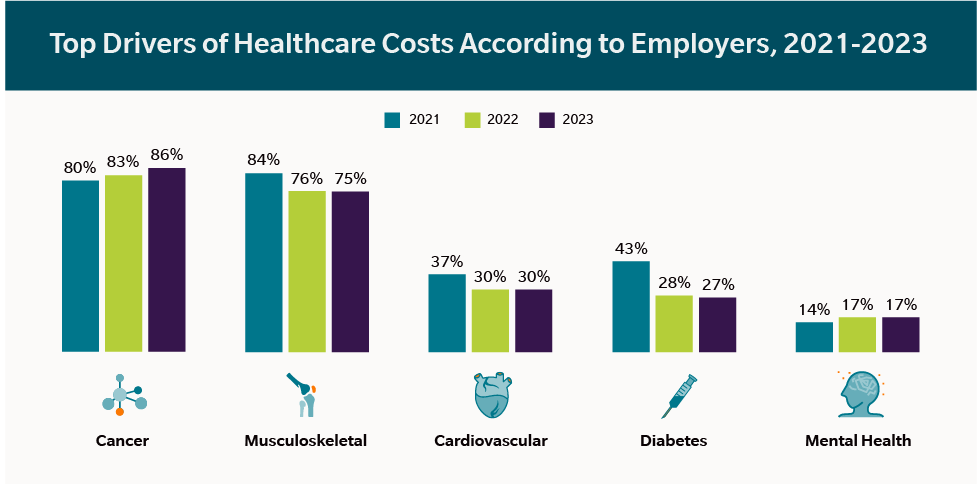Everyone knows smoking causes lung cancer. But what about smoking and breast cancer? Or smoking and bladder cancer? Many employers may not be aware of how many cancers are linked to tobacco use—and how much that may be costing.
Cancer costs today are increasingly top of mind for employers as they look to contain healthcare expenses. According to a Business Group on Health 2024 Large Employer Healthcare Strategy Survey, 1 in 2 employers say that cancer is the number 1 driver of healthcare costs and 86% say it ranks among their top three.
The focus on cancer among employers is up from the past few years (80% in 2021) and dwarfs other conditions such as cardiovascular disease and diabetes.
Smoking causally linked to 12 different cancers
While lung cancer or mouth and throat cancer may be most commonly associated with smoking, smoking actually causes about 20% of all cancers and about 30% of all cancer deaths in the U.S.
In fact, tobacco use is responsible for at least 12 different types of cancer, including acute myeloid leukemia (the most fatal type of blood and bone marrow cancer), as well as cancers of the stomach, pancreas, and esophagus. And two of the cancers linked to tobacco use—bladder cancer and colorectal cancer—historically have the highest lifetime treatment costs per patient of all cancers.
Adults exposed to secondhand smoke are also at higher risk, since adults exposed to secondhand smoke have a 20-30% higher chance of developing lung cancer. In fact, 7,300 lung cancer deaths occur each year among U.S. adults who do not smoke.
Total healthcare spending related to cancer is projected to reach $246 billion as soon as 2030, marking a 34% increase since 2015. But there are ways to contain these costs for employers, starting with investment in an effective quit-tobacco program.
How quitting smoking can prevent cancer
Quitting smoking lowers the risk of all 12 types of cancer. As summarized in the 2020 U.S. Surgeon General’s report, quitting leads to:
- Chances of getting cancer of the mouth, throat, or voice box dropping by half within 5-10 years;
- Chances of getting cancer of the bladder, esophagus, or kidney decreasing within 10 years;
- Risks of lung cancer dropping by half within 10-15 years;
- Risks of cervical cancer dropping by half within 20 years; and
- Risks of getting cancer of the mouth, throat, voice box, or pancreas dropping to close to that of a non-smoker within 20 years.
Quitting smoking also has numerous short- and long-term benefits to tobacco users beyond lowering their risk of cancer. Those benefits are seen most readily by employers in reduced healthcare costs and increased productivity in the workplace.
Helping employees quit smoking
EX Program by Truth Initiative is a proven effective tobacco cessation program designed specifically for employers and health plans. Our program has a 52% quit rate among employers using our best practices, and our strategic Client Success team are experts at tailoring plans for each client that enroll and engage individuals in stopping smoking, vaping, and nicotine use.
To learn more about how we can help, please visit our Employers page. Or, complete a Contact Us form to start a conversation and schedule a demo today to see how we help your employees quit for good.





